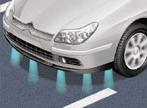
Citroën was the first carmaker to offer a lane departure warning system in the UK, with its large and largely unloved C5 saloon. Citroën’s system uses downward-looking infrared sensors mounted just behind the front bumper.
The sensors detect lines painted on the road, and if the vehicle strays across a line without the driver flicking an indicator, the driver is duly alerted to the fact. In the Citroën’s case, the reprimand comes in the shape of a tingling in the bottom, as either a left or right buttock is jiggled using one of a pair of vibrators mounted in the seat base. Which may, in fact, encourage a certain category of driver to weave all over the road.
French component supplier Valeo and US-based firm Iteris have clubbed together on a different and less intimate lane departure detection system, dubbed LaneVue by Valeo and AutoVue by Iteris.
Vibrator fetishists will be disappointed to learn that it uses the car stereo to warn the driver if the car strays out of its lane without indicators being used. The left or right speaker issues a rumble-strip noise to warn the driver that the line has been crossed.
To detect where the lines are, the Valeo/Iteris system uses a forward-looking optical sensor mounted high-up in the windscreen. The same sensor can be used to trigger rain-sensitive wipers or automatic headlights. 
The optical sensor scans the road ahead and performs continuous image analysis to work out where the painted lines are several car lengths ahead. It can then work out where the lines pass under the car.
Also on Valeo’s books is one of the current crop of gizmos designed to swivel headlights as the car corners, to better illuminate the road ahead.
Obviously not a new trick – Citroën’s DS had mechanical swivelling headlamps in 1955 – the current generation is nonetheless rather clever. Valeo's unit gobbles up data about steering angle and road speed and instantly works out where best to point the lamps, in dipped or main beam mode, up to 15 degrees from the straight ahead.
There’s clearly some room to amalgamate these two lines of technology; of lane detection and headlight aiming.
The obvious drawback to the current headlight swivelling system is that it gets its situation analysis from the steering. It intrinsically assumes, therefore, that you want to see around a corner you’re already in. Great for long, smooth, constant-radius corners of the kind found in car brochures and almost nowhere else.
In the real world, there are S-bends. And there are corners that get sharper when you least expect it.
What the keen driver really wants are headlights that shine round corners just before you turn into the bend, so that you can see where you're going before you get there. What we want is for the headlight-aiming-pixie in the black box to look at the lines ahead and know where the road is about to go, just like the driver does.
That, presumably, is what Valeo is working on right now. If not, it ought to start.
See the light
31 July 2005



